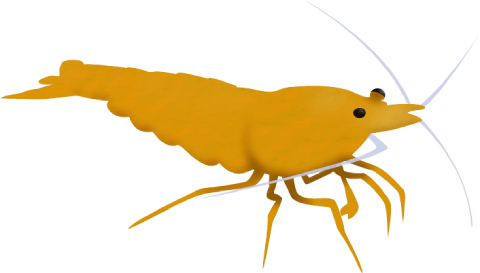- Common names
- Orange Sakura
Water parameters
- pH
- 6.5 - 8.0
- GH
- 4 - 10
- KH
- 1 - 8
- TDS
- 100 - 180
- Temperature
-
15 - 30 °C
59 - 86 °F
Facts
Difficulty level- Easy
Lifespan- 1 - 2 years
Origin- Taiwan
Adult size- 30 mm / 1.2 inches
The Orange Pumpkin is an orange variant of the Cherry shrimp, sitting right in the middle of the colour spectrum between a Red Cherry and a Yellow Fire. It’s part of the same Neocaridina family of shrimp that originates from Taiwan.
A mature shrimp will reach 3 cm (1.2 inches) in length when fully grown.
Grades
The higher grade Orange Pumpkins, especially the females, will be vibrant orange in colour, like an orange highlighter. Their shell will consistent in colour, having no patches that are translucent or spotty.
A low grade generally has a much weaker colour, like a warm yellow. Their bodies will have more spotty patches of colour and sometimes be quite translucent, similar to Rili shrimp.
Care
It’s not difficult to care for Orange Pumpkin, similar to other Neocaridina variations; they’re surprisingly resilient. They can easily live for up to 1-2 years in a tank with good water quality and consistent care.
Their hardy nature allows them to thrive in a range of water types and parameters. It’s important to try and ensure the KH is kept between 1 and 8, along with the GH from 4 to 10 to reduce the chances of any failed molts.
Unless you live in a very cold climate, Orange Pumpkin shrimp don’t require a heater. They should be fine as long as your room stays within the 15-30 °C (59-86 °F) range all year round.
Orange Pumpkin should be kept in a minimum tank size of 5 gallons (19 liters), however larger tanks of 10 gallons (38 liters) are preferred as it’s easier to control the water parameters with more water.
Diet
All freshwater dwarf shrimp eat the same food in general. They’ll spend most of their time in the aquarium seeking out biofilm and algae, which builds up on practically any surface, including the hardscape and aquarium walls. If your tank is established and full of plants, they should have plenty of natural food to eat.
If you’re not sure if there’s enough biofilm in the tank, feed your shrimp typical meals like algae wafers, bee pollen, shrimp pellets, blanched veggies, and so on.
Your Orange Pumpkin shrimp will obtain all of the nutrients they need to develop correctly and safely molt if you feed them a well-balanced diet of different types of food.
Tank mates
Introducing multiple Neocaridina colours will likely result in “wild type” offspring; a morph which is nearly transparent but with brown spots/stripes. You should aim to keep only one colour together at a time if your goal is to produce higher grade shrimp babies.
Orange Pumpkin shrimp and Amano Shrimp are a popular combination. The Amano may grow to be a little bigger, and their colours and patterns set them apart from the other Neocaridina. There’s also no possibility of interbreeding because they’re a separate species that needs brackish water to raise their young.
Find the ideal water parameters and compatible tank mates for Orange Pumpkin shrimp.
Popular fish, such as a Betta fish, can sometimes be kept safely with your Orange Pumpkin shrimp. However, there’s always a risk the fish may mistake your shrimp for a snack, so make sure the shrimp have plenty of hiding places if you try this. As this behaviour varies from fish to fish, there’s no clear cut criteria for “shrimp safe fish”, it’s unfortunately trial and error. Baby shrimp are more likely to be eaten, so it’s best to keep any fish out of the tank, especially if you’re trying to build up a big colony.
Almost any snail will be able to live in the same tank as a Orange Pumpkin colony, for example: Ramshorn or Nerite snails. The hardwater preference of the shrimp also benefits the snails as they can easily get all of the minerals they need to form a strong shell.
Breeding
In contrast to Caridina shrimp, when different colours of Neocaridina shrimp interbreed, the babies will normally be a lower-grade version of one parent. The babies could go straight to a very weak orange, or a “wild type”.
By consistently culling (i.e. moving to a separate tank) the Orange Pumpkins with weak colouring, you can gradually improve the grade of your colony. You’ll need to be patient when trying to climb up the grades though as there are no guarantees with nature and you could have a mix of grades for quite a while.
However, there are a few shrimp breeding tips you can read to try and improve your chances and hopefully speed this process up.


